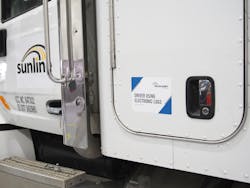Dissecting the trucking distress surrounding ELDs
So I had the good fortune to chat with a good number trucking company personnel this week at the McLeod Software 2017 User Conference in Atlanta and none-too-surprisingly, electronic logging devices (ELDs) proved to be the “talk du jour” of the show.
From the presidents of small fleets on down to front-line dispatchers, most felt the shift to ELDs would be nowhere near as difficult as what the industry underwent when deregulation hit back in 1980.
“At the time that was catastrophic to our industry; we were in denial,” recalled Lamar Quinn, general manager of R.E. Garrison – a man with 44 years of trucking experience under his belt.
“But we missed so many opportunities when we went through that exponential-level change at that time,” he stressed. “So now, with ELDs, we need to seize the opportunities that will arise over the next five years. This will be all about fear versus reality.”
I might note that the word “fear” here may not be appropriate the discussion revolving around ELDs, especially at the driver level – frankly, because most of the drivers I’ve met during my time in the industry rarely “fear” anything after their experiences on the road.
[Riding shotgun in a fully-loaded tractor-trailer negotiating steep grades along Wyoming’s I-80 in the teeth of a violent hail storm changed my perspective of the word “fear” in a hurry. For the guy piloting that rig, though, it was just another day on the job.]
What many drivers not yet using electronic logs are worried about is whether they’ll lose pay when they switch to ELDs – or if they’ll find themselves left stranded, out of hours and unable to drive home, even if home is just 50 miles away.
Here are a few of the other concerns I heard about ELDs and some of the “ripple effects” they might create for trucking:
- Several motor carriers said they are discovering that some drivers can become more “aggressive” as the time winds down on their electronic clock; especially if they’ve been delayed at the dock, by weather or by traffic. The last two hours seems to be the timeframe when there’s more self-directed pressure to “hurry up” and possibly speed in order to make a delivery window.
- The direct time strictures imposed by an ELD will make searching for truck parking that much harder. Back in May, mobile app developer TruckerPath released a report based on a poll of 3,330 truck drivers that found it’s “nearly impossible” for a driver to find parking within 45 minutes during evening hours. TruckerPath also discovered that 79% of drivers it polled are forced to violate hours of service (HOS) rules because they could not find parking.
- Drivers are concerned law enforcement officers won’t know how to decipher ELD information. On top of that they’re worried that they won’t know how to produce that electronic logging information when asked.
Yet those fleets that have already made the switch to electronic logging by and large report that once they’re drivers acclimate to the technology, they don’t want to return to paper logbooks. But it does require a lot of adjustment, warned Jerry Harris, vice president of Gypsum Express.
“The [HOS] rules have not changed; it’s just moving to a different way of recording them,” he explained. “But now the 14 hour on-duty and 10-hour off-duty clock is clearly defined. Now we all need to be cognizant of that clock. You’ve got to figure out where you are wasting time and where you are not.”
In terms of law enforcement, though, Harris found that having an “electronic log” sticker on Gypsum’s trucks makes things easier from a roadside inspection perspective.
“They are more favorable to us by running electronic logs but they make sure we’re doing it right – that we have the backup paper logbook and a ‘cab card’ available explaining to them how to obtain the HOS information from our system,” he said.
Harris stressed, too, that the move to electronic logging “has been talked about for years” in trucking and that the real stress is going to be felt by shippers and receivers, not the drivers.
“ELDs are going to create a more level playing field but not just with other trucking companies but with our customers and brokers,” he emphasized. “They’ve never had to change their [shipment] parameters because someone would always haul that load. We’re hoping that scenario goes away. We’re now willing to tell the customer that can’t happen when a load can’t be hauled legally.”
We’ll see if this expectation is truly met once electronic logging becomes mandated technology this December 18.
